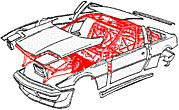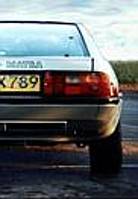 The chassis
The chassisIn 1979, the Simca brand was changed to Talbot (PSA) - and around this time Matra launched a new car, The Murena. Still a 3-seater - but with an even more aerodynamic body, and a bigger engine - two versions were built, a 1.6 and a 2.2. The 1.6 got its engine from the Talbot Alpine/Solara range - a very robust, humble pushrod engine, and the 2.2 engine was the one used in the Talbot Tagora (the one that looked like an enlarged Solara)
 The chassis
The chassis
The air resistance coefficient is down to 0.32 (which makes it the worlds most sleek mid-engined sportscar up to 1988 where the Panther Solo came along), so even with the relatively high weight the car is reasonable quick - 0-100 km/h is done in 11.2 sec. The 2.2 version is somewhat heavier, but has 25HP more, which pushes it from 0-100km/h in 9.6 seconds. Moderate tuning of the 2.2 engine (primarily a performance camshaft) easily increases the power by another 25HP.
 The suspension
consists of longitudinal torsionbars in front (as on the Simca-1100 and Talbot Alpine) - but at
the back the transverse torsion bars have been replaced with McPherson struts. The brakes are discs
all around. The balance of this car is extremely good, and the tire-grip is astonishing - you'll
take corners in this car much faster than in most other cars ... it is very adictive ;-).
The suspension
consists of longitudinal torsionbars in front (as on the Simca-1100 and Talbot Alpine) - but at
the back the transverse torsion bars have been replaced with McPherson struts. The brakes are discs
all around. The balance of this car is extremely good, and the tire-grip is astonishing - you'll
take corners in this car much faster than in most other cars ... it is very adictive ;-).
 In 1980 Matra had developed their
project P-18 as replacement for the
Matra-Simca Rancho, but since PSA didn't feel they had the
money for it Matra were turned down - and Matra went on to Renault, who accepted the idea ...
In 1980 Matra had developed their
project P-18 as replacement for the
Matra-Simca Rancho, but since PSA didn't feel they had the
money for it Matra were turned down - and Matra went on to Renault, who accepted the idea ...
It is a urban legend that Renault feared the competition from the Murena to their Alpine and
especially Fuego models, but this has never been confirmed, and frankly, the Murena is neither
in Alpine arena (too low power), nor was it a threat to the Fuego (it way bypasses it, but was
also quite a bit more expensive, due to the manual assembly).
The real (and confirmed) story is, however, that Matra only had the one factoryline, capable of
the warmgalvanizing of the steel chassis and hand-assembling the cars, this alone forced them to
abandon the Murena.
In July the 2.2 litre prep-142 Murena-S was launched, to use up the remaining chassis and bodyshells. The 'Murena-S' was a 2.2 version tuned up to an astonishing 142HP which definately made it a fast car - 0-100km/h in roughly 8 seconds was easy to reach (some claim it was even faster). Matra did have plans to use the PSA 2.9l V6 also used in the Talbot Tagora - but for some reason (energy crisis, and political signals) Talbot didn't allow this. Also in the minds of the designers was (of course) to equip the car with Matra's own 11000 rev, screaming (formula-1) V12 engine (!) - in fact I have recieved a photo of this factory mock-up, evidently showing a Murena chassis with the Matra V12 mounted !!. With such sounds behind the drivers seat, nobody could possibly find traffic boring ;-) - These plans will remain dreams forever - but they did, however, produce a higly tuned 2.2 version called the Murena 4S - in which they squeezed 180HP out of the engine. The rear-wings had also been widened, to produce an air-intake for brake cooling and engine-feed. the frontspoiler was lowered further to keep the car to the ground, and a new distinguishing alloy design adopted. Only very few cars were built (3 I think) - in deep-blue , with green Murena-S markings.
By Christmas 1983 (when the factory closed down for the holidays) the last Murena rolled out from the factory - (it is said to have been a red 142HP Murena-S, which is not unlikely, as most of 1983 were 2.2's). Hereafter the productionline was converted to produce the P18 - better known as the Renault Espace, and today the same thing is happening again, as Matra have started producing the Avantime.
On Matra's own pages (of realised vehicles) it is furthermore
stated that the production of the Murena, caused them to invent a new technique:
Jean-Louis Caussin - the General Manager of Matra - explains: "In about the middle of the production,
we began to explore the SMC (Sheet moulding compound) moulding techniques,". "We had an enormous amount
of glass fibre cuttings and we asked our partner Mensolit, who supplied the epoxy resin, to help us
find a way to use it." The solution consisted in embedding this chopped glass fibre in a rolled paste
and depositing it at the bottom of a mould to be shaped under hot pressure. Several parts of the Murena
use this new procedure. Today, SMC is one of the most characteristic Matra manufactures procedure
techniques, thanks to its appearance qualities and its lower investment costs for medium series.
A total number of 10680 Murenas were built - which breaks down as:
Production per year:
| |||||||||||||||||||||||||||
The years in the table above are "production year", which increments sometime in autumn (September) to be able to produce the next years model, in time for the customer-demand. (a practice adopted by all automobile manufacturers). This means that 1984 in fact means during the last months of 1983, the assemblyline shutdown for Christmas, and was only reopened, when it had been converted to produce the Espace.
NB - these figures are not authoritative, - just some of the most detailed I have been able to locate. Different numbers can be seen quoted on the net, however, the total number is indisputed.
Aftermarket options for engineupgrades mostly concern the current Peugeot 1.9 engine (as used in the 205 GTI range) - since this engine has similar mountpoints and even weighs the same as the old 1.6 unit. Power is up to 120-130HP (the 16valve with two double Webers is about 150-170HP), which evidently makes the car a lot quicker, far better matching its looks. Here is what I currently have about the 1.9 conversions:
| m19-test.html | A test of two 1.9 converted Murenas - by Darren Elmslie |
| Murena 1.9 16v | now owned by Fraser Stephens (was Darren Elmslie's) |
| Murena 1.9 8v | belonging to Brian Smyth |
| Murena 1.9 8v | belonging to Laurence Hatfield |
| My own fuelinjected Murena 1.9i 8v | done by MatraMagic '99 |
| www.matrasport.dk | Lennart.Sorth@matrasport.dk |